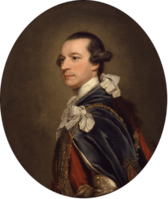Second Rockingham ministry facts for kids
Quick facts for kids Second Rockingham ministry |
|
|---|---|
 |
|
| March–July 1782 | |

Rockingham (after Joshua Reynolds)
|
|
| Date formed | 27 March 1782 |
| Date dissolved | 1 July 1782 |
| People and organisations | |
| Monarch | George III |
| Prime Minister | Lord Rockingham |
| Total no. of members | 16 appointments |
| Member party | Rockingham Whigs |
| Status in legislature | Majority 234 / 449
|
| Opposition party | Grenvillites |
| History | |
| Legislature term(s) | 15th GB Parliament |
| Predecessor | North ministry |
| Successor | Shelburne ministry |
This article is about the important people who held government jobs during the time Lord Rockingham was Prime Minister. This was his second time in charge, and it lasted for about four months in 1782. A "ministry" is like a team of top government officials led by the Prime Minister.
The previous government, known as the North ministry, had to resign on March 22, 1782. This happened because they lost the trust of the Parliament (the main law-making body) after Britain lost a big battle called the siege of Yorktown during the American War of Independence.
After this defeat, Lord Rockingham, a leader of the Rockingham Whigs political group, became Prime Minister. He had been Prime Minister once before, from 1765 to 1766. The Rockingham Whigs generally supported the American colonists who were fighting for their independence. Under Rockingham's leadership, the British government started talking about peace. These talks eventually led to the Peace of Paris in 1783, which officially ended the war.
Sadly, Lord Rockingham died on July 1, 1782. His death caused a big disagreement within the government. Lord Shelburne, who was the Home Secretary (in charge of internal affairs), was chosen to take over as Prime Minister. However, some members of Rockingham's team refused to work under Lord Shelburne and resigned. These people were called the "Portland Whigs," named after their leader, the Duke of Portland. But the real leader of this group was Charles James Fox. This group then joined forces with Lord North (the former Prime Minister) to oppose Shelburne. Together, they managed to bring down the Shelburne ministry in 1783 and formed their own government, known as the Fox–North coalition.
Key Government Leaders (1782)
This section lists some of the most important people who served in Lord Rockingham's government. These individuals were part of the "Cabinet," which is a small group of the most senior ministers who make big decisions.
Prime Minister and Treasury Leader
- The Marquess of Rockingham: He was the First Lord of the Treasury, which is another name for the Prime Minister. He also led discussions in the House of Lords, one part of Parliament. He served from March 27, 1782, until his death on July 1, 1782.
Important Cabinet Roles
- The Lord Thurlow: He held the role of Lord Chancellor. This is the highest legal position in the government and involves advising the King on legal matters and leading the justice system.
- The Lord Camden: He was the Lord President of the Council. This person leads the Privy Council, which advises the King.
- The Duke of Grafton: He served as the Lord Privy Seal. This role involves approving important government documents.
- Lord John Cavendish: He was the Chancellor of the Exchequer. This person is in charge of the country's money and finances.
- The Earl of Shelburne: He was the Secretary of State for the Home Department. This job involves managing affairs within the country, like law and order.
- Charles James Fox: He was the Secretary of State for Foreign Affairs. This means he handled Britain's relationships with other countries. He also led discussions in the House of Commons, the other part of Parliament.
- The Viscount Keppel: He was the First Lord of the Admiralty. This person was in charge of the Royal Navy.
- The Lord Ashburton: He was the Chancellor of the Duchy of Lancaster. This role manages the lands and income of the Duchy of Lancaster, which belongs to the monarch.
- The Duke of Richmond: He was the Master-General of the Ordnance. This person was responsible for military supplies and weapons.
- Henry Seymour Conway: He held the title of Commander-in-Chief of the Forces. This was the top military commander.

